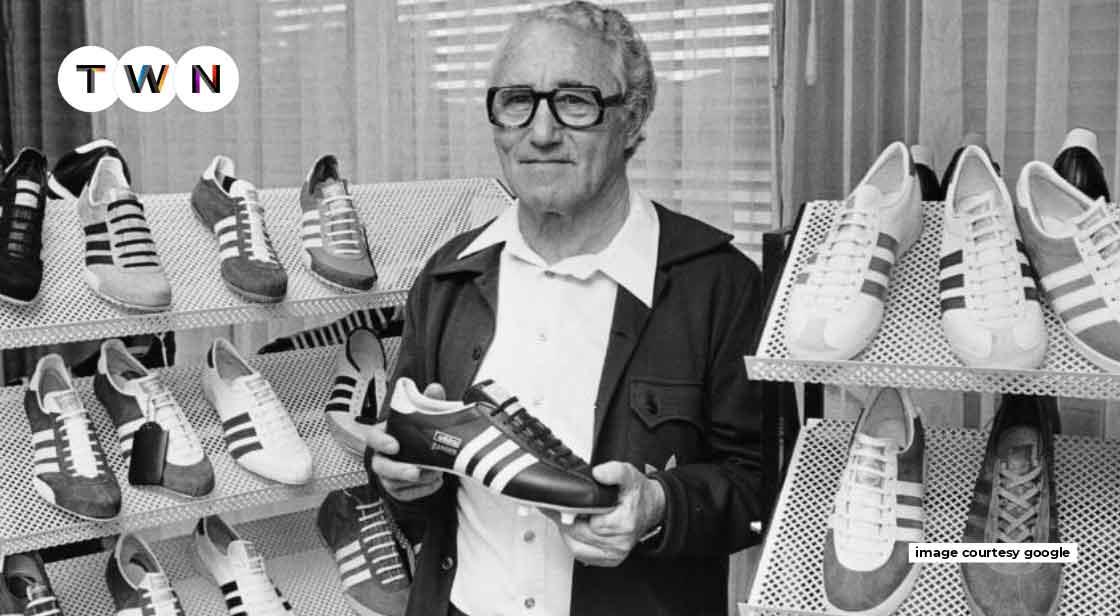Adolf Dassler: The Leader Behind Brand Adidas Success

Blog Post
Adidas is one of the world's most successful sports companies, with more than € 23 billion in annual revenue and 60,000 employees worldwide, but it began as a family business motivated by the innovation and passion of a German man named Adolf Dassler.
Adolf Dassler spent his entire life in a small rural town in Bavaria, where he handcrafted his first pair of sports shoes. His company nearly went bankrupt several times before becoming a global success. His extraordinary life is a story of ingenuity, creativity, and, above all, a love of sports. Let’s explore the success story of Adidas Founder: Adolf Dassler! #TWN
Adolf Dassler: His Early life of Adidas Founder
Adolf Dassler was the youngest of the four siblings born in the German town of Herzogenaurach in 1900. His father, Christoph, worked as a tailor, and his mother, Pauline, ran the family laundry. Adolf finished high school and, at his father's request, began an apprenticeship as a baker. Although he completed this training, a life of bread making did not appeal to him, so he decided to learn the skills of shoemaking instead.
Adolf's main interest outside of work was sports. He played and competed in a variety of sports, including track and field, football, boxing, ice hockey, skiing, and ski jumping, accompanied by his childhood friend Fritz Zehlein (the son of a local blacksmith, who plays an important role later in the story). Through his exposure to such a diverse range of sports, he made a key observation that would later serve as the foundation of his success: he noticed that all athletes wore essentially the same shoes.
World War I
Adolf Dassler was forcibly recruited into the German Army in the late stages of World War I before he could immediately turn his sports shoe idea into a business. In 1919, when he returned to Herzogenaurach, Germany was in the grip of post-war economic depression. Jobs were scarce, but Adolf was determined not to let his dream die, so he converted the old laundry shed at the back of the Dassler house into a shoe workshop. He earned money by repairing footwear for the locals, using the shoemaking expertise he had learned.
This gave him the resources and time he needed to create his first pairs of specialized sports shoes. One of his first inventions was a pair of spiked running shoes for track and field athletes, which were a brand-new concept for the sport at the time. They had hand-forged metal spikes provided by the local blacksmith, Fritz Zehlein, Adolf's childhood sports buddy.
The Dassler Brothers Shoe Factory is Born
Adolf's manufacturing processes were just as innovative as his shoe designs. He rigged a leather milling machine to a bicycle that was peddled by the company's first employee to solve the problems caused by unreliable electricity supply.
Adolf was joined in his venture by his older brother Rudolf Dassler, and on July 1st, 1924 they registered their company as 'Gebrüder Dassler, Sportschuhfabrik, Herzogenaurach' ('Dassler Brothers Sports Shoe Factory, Herzogenaurach'). By 1925, their fledgling business had three employees working in their one-room workshop, manufacturing leather football boots with nailed studs and spiked track shoes. As the German economy improved, business increased, and the brothers moved to a larger building in Herzogenaurach, where they invested in infrastructure machinery and expanded their production.
As they built their brand, they also focused on engaging with their audience and understanding the power of visibility. In today's digital world, for instance, businesses looking to increase their presence might consider strategies to get some followers on social media to enhance their reach and impact.
Adolf Aims for Olympic Success
The World Cup of Football (soccer) and the Olympic Games were the two most important global sporting events in the late 1920s and early 1930s. The Dassler brothers suspected that if they could get their shoes on the feet of athletes, it would help them succeed and validate the Dassler product's quality. Adolf gave German marathoner Lina Radke a pair of his spiked track shoes at the 1928 Olympics in Amsterdam, and they had their first success. Lina won the contest with a World Record time because it was the first time women were allowed to compete in the 800m distance.
Adolf's innovative technology in sport's shoes was inspired by the specific needs of the sportsmen he worked with. He included testing and feedback as part of the creative process to ensure the merchandise was the best it could be.
Also Read: Let's Take You To Indra Nooyi's Journey
Through Coach Josef Waitzer, he quickly established a relationship with the German National Track & Field team. This collaboration not only gave effective feedback for product development but also ensured that many German athletes would be wearing Dassler shoes at the Olympic Games. At a time when no athletes had expert sponsorship, the Dassler brothers' marketing strategy was brilliant.
They had success with German athletes at the 1932 Los Angeles Olympics, so they decided to take the concept to an international audience for the 1936 Berlin Olympics.
Jesse Owens and Adolf Dassler
Adolf formed a friendship with Jesse Owens, a promising Black American athlete. Adolf stepped in to help Jesse when he lost his track shoes on the way to the Berlin Olympics, according to photos from the time. He met with the athlete and gave him some 'Dassler Brothers' shoes to try on. Although there is no conclusive evidence of what happened after that meeting, legend has it that Jesse wore the Dassler shoes on his way to winning four gold medals. What we do know is that Jesse stayed in touch with Adolf Dassler after the event and later became an Adidas ambassador.
Adolf's friendship with Jesse Owens may have had far-reaching consequences beyond product marketing. When American troops were dismantling the Nazi regime's apparatus at the end of WWII, they destroyed factories that had been linked to the war effort. Because the Dassler brothers' factory had been taken over to manufacture weapon components, it was set to be demolished at the end of the war. However, when American officers learned of the factory's connection to Jesse Owens and the 1936 Berlin Olympics, the factory was spared.
The Nazi Party and Dassler’s Life in wartime Germany
Adolf and Rudolf Dassler joined the National Socialist Party on May 1, 1933, and remained members until 1945, when the war ended. There is no evidence that Adolf joined the party because of a strong personal belief. It was common for business owners to join as part of an agreement with the new National Socialist government that would help ensure the company's continued success.
The destiny of the Dassler Brothers Sports Shoe Factory seemed ambiguous as the Nazi Party began its march to war.
The brothers were initially permitted to operate a limited production of sports footwear, but they struggled to find good materials and staff. Adolf Dassler was forcibly recruited into the German Army (Wehrmacht) and began training as a radio operator in nearby Zirndorf in 1940, causing further disruption to the business. He fought his call-up and was eventually discharged in 1941 after it was ascertained that his skills were critical to the operation of the Dassler factory.
The simmering tension between Adolf and Rudolf, which had now begun to boil over, was another factor disrupting business. The brothers had conflicting ideas about how to keep the business afloat during WWII, and in 1941 they decided to split up (before finding it was impossible because of the war). Adolf and Rudolf's families were living with the aging Dassler parents at the time. When Rudolf Dassler was drafted into the German army in 1943, leaving Adolf alone to run the factory, the family and business relationships were further strained.
Later that year, in 1943, the brothers' sports shoe business was nearly destroyed. The Nazis had declared 'Total War,' and to avoid a total shutdown of the company, Adolf Dassler was prompted to become a distributor to the Nuremberg firm Schricker & Co, which was manufacturing a basic anti-tank missile launcher. Dasslers' factory machinery was replaced, employees were retrained, and shoe manufacturing was gradually phased out. The factory continued to produce parts for Schricker & Co until the end of the war, though evidence suggests that Adolf attempted to repair and produce a few pairs of shoes at the same time.
Post-war
Germany went through a process of denazification at the end of WWII, which affected many German citizens in some way. Although the factory of the Dassler brothers had been spared destruction, the family was still engaged in the denazification process.
Adolf Dassler was classified as a 'Lesser Offender,' and the company was placed under the supervision of a trustee. This made restarting Adolf's sports shoe business extremely difficult. Then, through an appeals process, he was able to demonstrate that he had never been an active supporter of the party. He relied heavily on testimony from respected Herzogenaurach residents, employees he had assisted, and even a Jewish friend he had taken in and protected from the Nazis. His party affiliation was eventually reclassified to 'Follower,' and he was able to regain control of the company as an owner once more.
The Family Split and the Origins of Puma
The stress of the war, as well as the years that followed, permanently separated Adolf and Rudolf Dassler. In 1948, they officially disbanded their business.
They split the company's assets and became business rivals as a result. Rudolf started his own sports shoe company, Puma, which he eventually sold. Both Adidas and Puma continue to have their global headquarters in Herzogenaurach.
The Creation of the Company ‘Adidas’
Adolf Dassler attempted to re-establish the company in a depressed German economy during the years immediately following the war. He had to rely on his creativity and entrepreneurialism more than ever before. He had established a link with American military officers billeted at the Dassler family home and was able to obtain leftover wartime materials as a result of this relationship. He created shoes out of aircraft fuel tank liners, rubber rafts, and tent canvas in the absence of leather.
Following his brother's departure, Adolf wanted to ensure that his products had a distinct appearance so that people could easily identify them on the feet of athletes. He played around with the decorative straps on the sides of his shoes, changing up the number and adding color. He eventually settled on three straps, and the 'three stripes' brand was born. In 1949, Adolf began using the 3-stripe logo as the company's trademark.
Instead of completely rethinking Adolf's (nicknamed Adi) name, he simply added an "I" to the printed form. As a result, Adidas was born. 'Adolf Dassler "Adidas" Sportschuhfabrik' was the original company name, which was registered on August 18, 1949.
Also Read: Amazon Business Is Winning. Here’s Why
Global Domination as Adolf Dassler Continues to Innovate
Adidas employed over 500 people in the 1960s and was the world's largest sports shoe manufacturer. Despite his age and the success of his company, Adolf Dassler continued to obsessively innovate, creating Adidas shoes that were lighter, more comfortable, and met the needs of athletes.
Working with the German National Football Team in 1963 inspired Adolf to create a shoe that would help athletes avoid bacteria and fungi foot infections in the locker room. The Adilette, a hugely popular leisure shoe, was the result. He created the first track and field warm-up suit in 1967, giving birth to the tracksuit and a whole new world of sports apparel.
Horst, Adolf and Käthe's son, rose to prominence in the business in the 1960s. Horst Dassler recognized the potential of new sports and assisted Adidas in expanding its market in the United States. He applied Adolf's innovative spirit, among other things, to the development of basketball shoes, and the Superstar was born – now a streetwear icon. Adolf and Käthe were married until his death in 1978, at the age of 77. Käthe continued to run the company with her son Horst until she died in 1984.
His designs influenced athletes all over the world, and they helped to launch a global sports shoe industry worth tens of billions of dollars per year. Despite his wealth and success, Adi remained humble, returning to where he felt most at ease – in the company of athletes, thinking about how his products could help them perform better.
You May Like
EDITOR’S CHOICE












